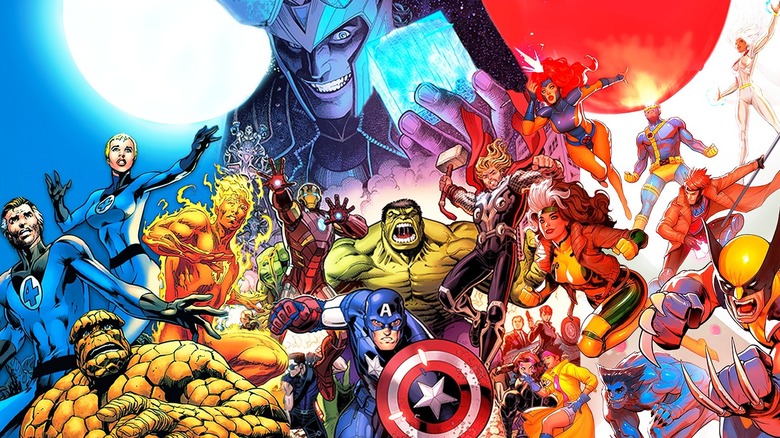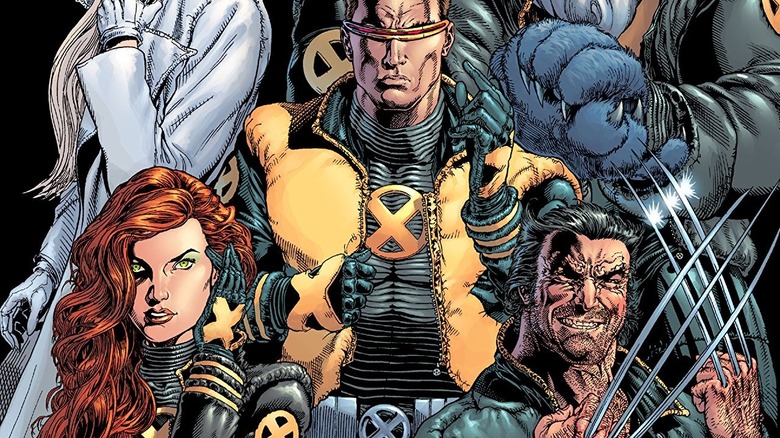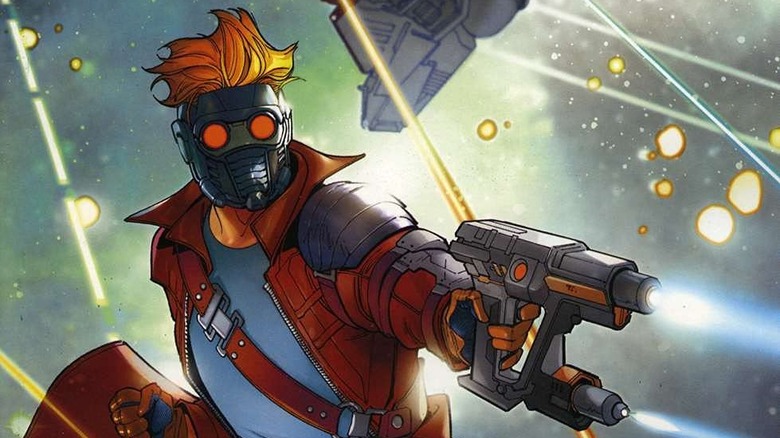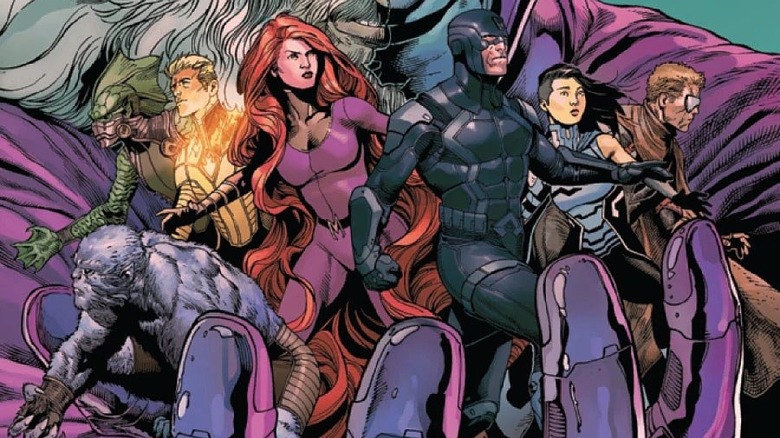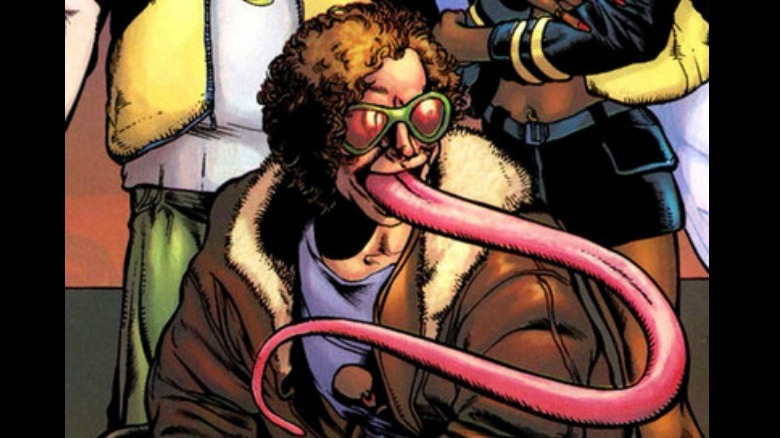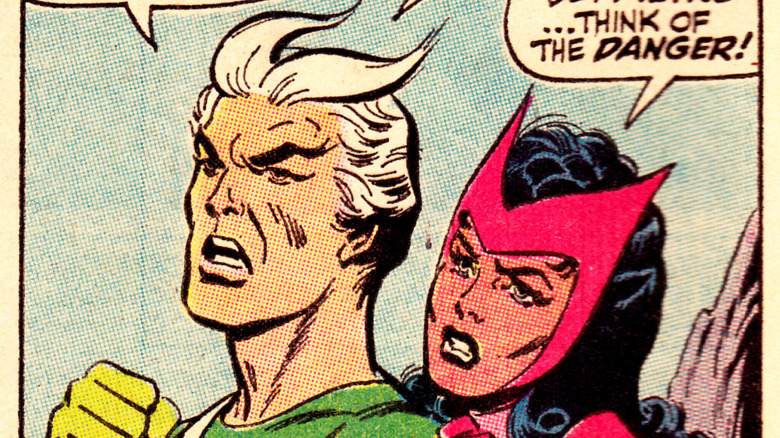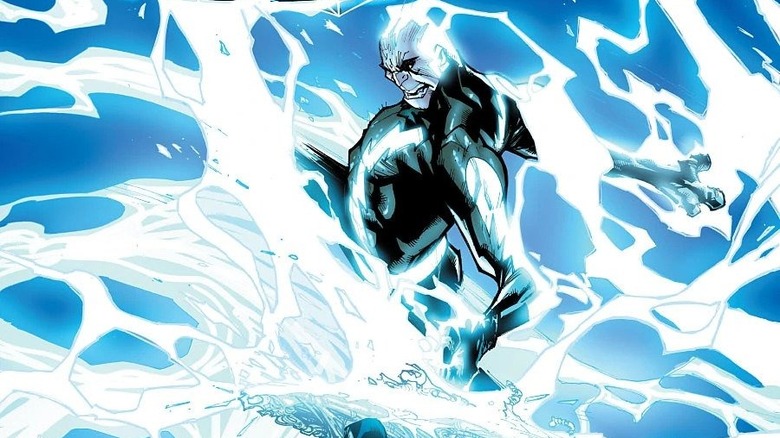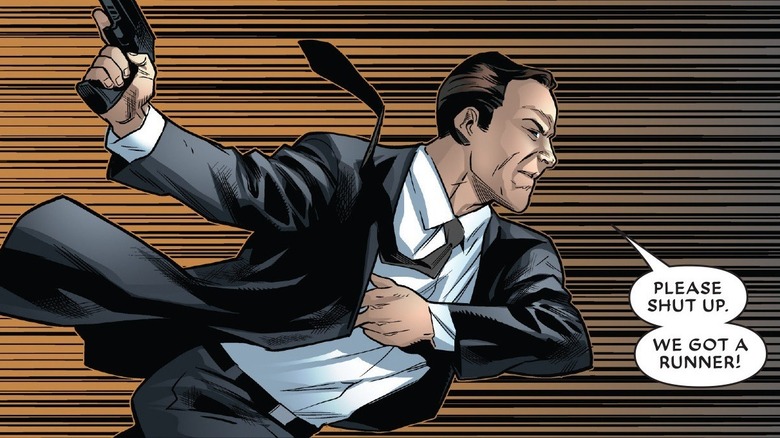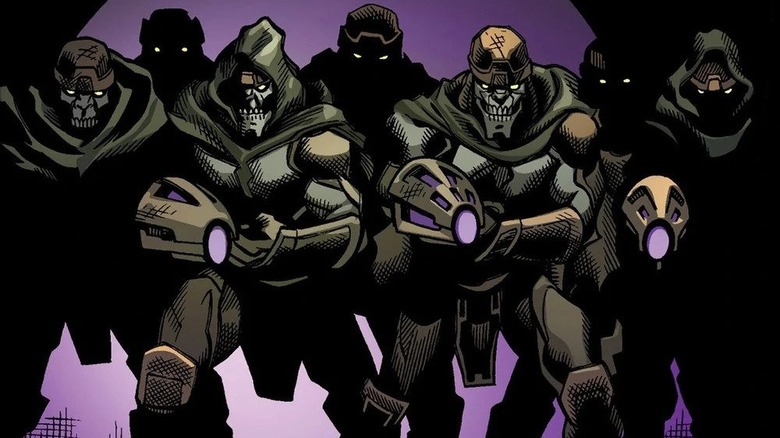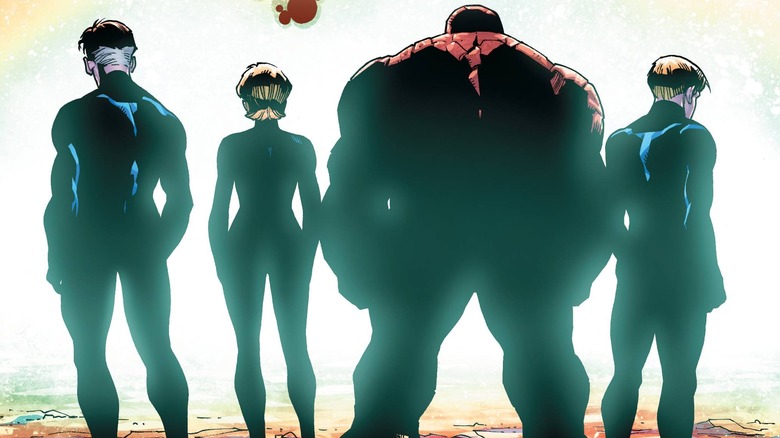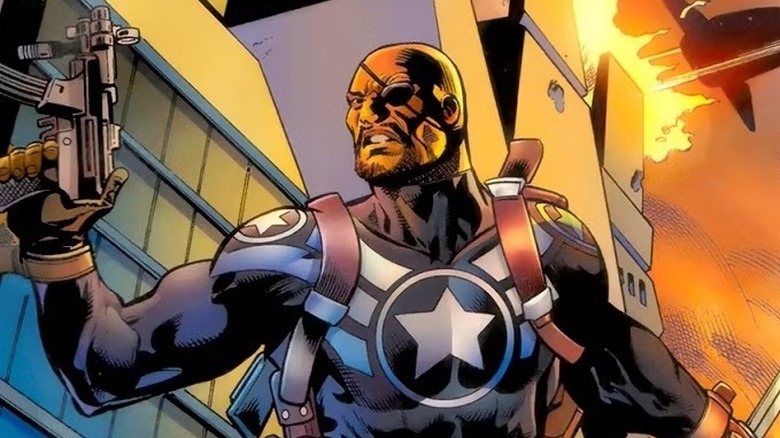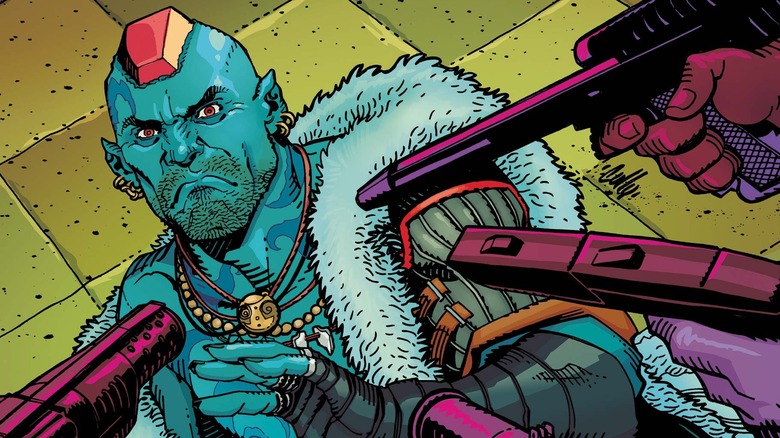12 Times That Marvel Movies Led To Changes In The Comics
Ever since the world of Marvel Comics as we know it was launched with the introduction of the Fantastic Four in 1961, it has expanded exponentially into a massive macrocosm filled with countless heroes, villains, worlds, and timelines. It's a testament to just how powerful the work created by Stan Lee, Jack Kirby, Steve Ditko, and others was all those decades ago that it continues to thrive and thrill audiences even today. The idea of crafting characters who were just as interesting in their costumes as they are outside of them was a pretty groundbreaking one in the realm of comic books; is it any wonder why so many Academy Award winners and nominees have signed on to play these near-mythical figures in various Marvel movies over the last couple of decades?
Yes, there's no doubt that the complex and interconnected reality of Marvel Comics was a considerable influence on their cinematic versions. However, did you know that, despite the source material's inspiration for the movies, the films have inspired plenty of changes in the source material? It's totally understandable that the filmmakers would change certain elements from the comics, as there are some things that just don't translate well from page to screen. But when the film becomes a hit, the big screen depiction becomes the audience's idea of the world and characters presented to them, which often establishes a new standard in comic books in order to decrease confusion for new fans.
The X-Men get new black duds
The X-Men made their grand comic book debut in 1963 and were depicted in their early years with matching black and yellow (although sometimes depicted in blue and yellow) uniforms before eventually getting brighter, more colorful, and more individual costumes. This was the norm for the main titles as well as the various other series that spun out of them, all the way through the early 2000s. For those of us who grew up in the 1990s, our version of the team wore the classic Jim Lee-inspired getups that were featured in the beloved animated series.
While 1998's "Blade" was the first sign of how Hollywood was going to change the characters for the big screen, it was really "X-Men," released two years later, that stripped the iconic characters of their vibrant attire and decked them out in more modern, all-black garb. The movie's Cyclops even made a sarcastic joke to Wolverine about wearing yellow spandex that was really a jab at fans who might've taken umbrage over how the characters looked more like they belonged in a "Matrix" movie than in a comic book movie. However, the following year, legendary writer Grant Morrison kicked off the "New X-Men" series that revamped the way the X-Men looked, which consisted of sleek black costumes that were an obvious nod to how they looked on screen. Since then, the X-Men have largely returned to uniforms that consist of more than two colors.
Spider-Man gets organic web-shooters
Everyone knows that Peter Parker is a bit of a nerd, but we often forget just how incredibly smart he really is. While not quite at the level of, say, Tony Stark or Reed Richards, he still has a genius-level intellect, and that was shown quite early in his existence. After getting bitten by a radioactive spider and deciding to put his new abilities to good use as a Spider-Man, Parker ran with the spider theme and designed devices to be worn on his wrists that shoot out artificial webbing. The tensile strength of the webbing is incredibly high, allowing him to swing from buildings and lasso up villains. Of course, the one drawback is that he often ran out of web fluid in the middle of battles, requiring him to carry spares with him.
Fans were thrilled when Sam Raimi gave us the first big-budget version of the wall-crawler in 2002, but got mad online at Raimi when Spider-Man was shown with the ability to produce web organically, greatly downplaying his scientific genius. However, the comic book version of the character followed suit not long after in 2005's "The Other" storyline, which sees him essentially killed and reincarnated with the ability to shoot webbing from his wrists – organically. While it's not entirely certain that this change was done to make the character more in line with his cinematic counterpart, it should be noted that Parker lost his organic web shooters right after the final Raimi "Spider-Man" movie came out.
Star-Lord gets Parks and Rec'd
Before he became Star-Lord, he was Peter Jason Quill, a fairly normal young boy living an ordinary life on Earth raised by his single mother. However, he becomes an orphan when his mother is murdered by an alien race, and he eventually trains to be an astronaut for NASA. Quill is then sent to a space station with other astronauts, and it's there that he's visited by an intergalactic being known as the Master of the Sun, which soon bestows him with a range of enhanced abilities and the title of Star-Lord, operating as a sort of interplanetary police officer. Star-Lord, having gone on countless adventures restoring peace and justice around the universe, becomes a rugged and cynical warrior before forming his own team, the Guardians of the Galaxy.
This is quite a bit different from the version of the character we saw portrayed by Chris Pratt in the MCU movies. The big-screen iteration of Star-Lord is much more tailored to Pratt's comedic sensibilities, which he honed for years on the hilarious sitcom, "Parks and Recreation." Charming, goofy, and much closer to a space pirate than a space cop, even Star-Lord's movie backstory was changed, being abducted by the intergalactic outlaws, the Ravagers, before saving the galaxy in a dance-off. However, Marvel Comics revamped both Star-Lord's personality and history to more closely adhere to the movie version of the character; his gruff, world-weary demeanor has been replaced with the sarcastic, swashbuckling persona that the films' fans are familiar with.
The X-Men are replaced by the Inhumans
Historically, the X-Men were always one of Marvel Comics' popular titles, launching seemingly infinite spinoff series, cartoon and live-action TV series, video games, and a (mostly) well-received franchise of movies. The Inhumans, on the other hand, despite being around since the early days of Marvel Comics, never achieved the same level of success as their mutant contemporaries. It's a bit of a shame, as the Inhumans have a fascinating backstory; eons ago, the alien race the Kree experimented on the earliest humans on Earth, eventually evolving into a secluded race ruled over by a royal family consisting of Black Bolt, Medusa, Karnak the Shatterer, Gorgon, Triton, Crystal, and others.
It was only a matter of time before the Inhumans would make the leap to live action, with a plotline featuring the race appearing in "Agents of SHIELD" leading up to a poorly received eight-episode miniseries. Because Marvel Studios couldn't use the X-Men at the time (they were owned by 21st Century Fox), it's been widely speculated that the comics reflected this, as the Inhumans began to take on a larger role, while the X-Men's role was drastically reduced. Longtime "Uncanny X-Men" scribe Chris Claremont more or less confirmed this on the Nerdist podcast (via Bleeding Cool), wherein he stated that Marvel Comics writers couldn't create new X-Men characters to cut back on who 21st Century Fox could include in their TV and film projects.
Toad's tongue transforms
Toad is one of the X-Men's oldest enemies, first encountering him when he was a member of Magneto's inaugural Brotherhood of Evil Mutants. His weak personality and diminutive size don't exactly scream supervillain, but he actually has a range of gifts that make him a formidable foe, including enhanced strength and stamina, expert hand-to-hand fighting skills, and the ability to stick to a range of surfaces. Despite his association with Magneto and his constant clashes with superheroes, Toad always managed to elicit sympathy from readers, as he spent much of his time serving as the bullied "toady" of other, stronger characters. He's even gone through phases fighting on the side of the angels, proving that he's more than just a malevolent henchman.
Toad made his live-action appearance in 2000's "X-Men," portrayed by professional martial artist and Darth Maul actor Ray Park. Here, he's portrayed in a much less pathetic light; while still working for Magneto, he's depicted as a far more capable — and even slightly sadistic — fighter to the X-Men. However, the biggest change that was made to him was the addition of a prehensile tongue that he uses to grapple and fling opponents with ease. The comic book version of Toad followed suit in the 2001 series, "X-Men: Forever," wherein he is experimented on and granted a whole new look, along with the aforementioned prehensile tongue. While his appearance has changed a bit since then, that villainous tongue has remained consistent.
Wanda and Pietro Maximoff's backstories are changed
In the comics, Wanda and Pietro Maximoff are mutant siblings who started off as villains in Magneto's Brotherhood of Evil Mutants as the Scarlet Witch and Quicksilver, respectively, before eventually defecting from his plans to rule the world to become heroes. Not only did they become heroes, but they became part of Earth's Mightiest Heroes as members of the Avengers. From then on, the two would spend much of their time on the side of the good as solo heroes, as well as part of various teams. One of the more fascinating parts of their history is the fact that they're the long-lost children of Magneto, which was revealed in the "Vision and the Scarlet Witch" miniseries.
Because Marvel Studios wasn't able to use Magneto — owned by 21st Century Fox at the time — a deal was worked out that allowed the characters to appear in films by both studios. The catch for Marvel Studios? They could not refer to Wanda and Pietro as mutants, and so it was revealed that they were orphans who volunteered to be experimented on by HYDRA, which resulted in their superhuman powers. Marvel Comics followed suit when, in "Uncanny Avengers" vol. 2 #4, it's revealed that the siblings are not mutants at all, but regular humans experimented on by the High Evolutionary. While the reason behind the decision hasn't been officially confirmed, the revelation did take place right around when "Avengers: Age of Ultron" was released.
Electro gets a new look
Electro is one of Spider-Man's oldest foes, tussling with the wall-crawler for almost 60 years, both as a solo villain and as a member of teams like the Sinister Six and the Emissaries of Evil. But before he became Electro, he was Max Dillon, a lowly employee for an electric company who's unfortunately struck by lightning while working on a power line. Instead of simply killing him, however, Dillon is given the ability to generate and manipulate massive amounts of electricity. Instead of using this power for good, he dons a green costume with massive yellow lightning bolts on his face so that everyone knows that his powers are electrical in nature, and becomes a supervillain.
Electro eventually made his way to the big screen by appearing in 2014's "The Amazing Spider-Man 2," portrayed by Jamie Foxx. The origin story is changed somewhat for the film, with Dillon depicted as an electrical engineer working for Oscorp, but his horrible accident is mostly retained here. The biggest change, however, comes in the form of his new appearance, which borrows a fair amount from the "Ultimate Spider-Man" version of the character; gone is the vibrant green-and-yellow getup, which is replaced by bluish skin and a black leather outfit. As expected, the mainstream continuity of Electro was given a new look, inspired by the Foxx version, only two years later in "The Amazing Spider-Man" vol. 3 #1 by writer Dan Slott and artist Humberto Ramos.
Phil Coulson leaps from screen to page
Phil Coulson made his first appearance in 2008's "Iron Man" as an agent of SHIELD planting the seeds for a wider world that exists just outside the frame. He would go on to appear in various other installments in the Marvel Cinematic Universe as Nick Fury's right-hand man, serving as the throughline that ultimately brings the heroes together as the Avengers. Coulson was killed by Loki in "The Avengers," but was revived for the spinoff series "Agents of SHIELD," where he and a special team of agents embark on various missions to protect the world from all kinds of supernatural and otherworldly threats.
Coulson was not based on any character from the comics, but he was so integral to the MCU and so beloved by fans that it only made sense for him to join the rest of his four-color friends. The character made his debut in the 2011 miniseries, "Battle Scars," followed by leading a team of agents in the ongoing series, "SHIELD" vol. 3. This series is also worth bringing up, as it was the one that introduced readers to the comic book versions of agents Melinda May, Leo Fitz, and Jemma Simmons, straight from "Agents of SHIELD."
The Chitauri get a makeover
The Chitauri is a shapeshifting alien race that served as one of the main antagonists to the alternate universe version of the Avengers in "The Ultimates" series. Determined to eliminate chaos and free will (which they believe to be the source of chaos), the Chitauri set out to subjugate the inhabitants of target planets by weaponizing their own military tactics against them. They first tried to infiltrate Earth by aiding the Nazis during World War II but were thwarted by Captain America, who ended up frozen in ice during his mission against them. Decades later, the revived Cap joins a team of other heroes to stop the Chitauri's new plan of world domination.
Because so much of the Marvel Cinematic Universe was borrowed from the Ultimate imprint at Marvel Comics, it only makes sense that the Chitauri would be brought in as villains in the first "Avengers" film. However, their depiction is quite a bit different in the movie, as they're shown as a straightforward alien race with no discernable shape-shifting abilities and functioning mostly as fodder for Earth's Mightiest Heroes to fight before taking down Loki. It's this more stripped-down portrayal of the Chitauri that made its way into the comics in "Nova" vol. 5 #4. Like the way they're seen in "The Avengers," the new version of the Chitauri is mostly a mindless army for heroes to plow through without remorse.
Did Marvel Comics write out the Fantastic Four to spite 21st Century Fox?
There's a good reason why the Fantastic Four are called Marvel's First Family. Introduced in 1961, this superpowered clan ushered in an age of superhero characters who more closely resembled real-life people and, in many cases, weren't thrilled about having enhanced abilities. What made the Fantastic Four so interesting was that, in between saving the world from threats across time and space, they still got into the same fights as a typical family. Because their powers came out by accident, it wasn't uncommon for them to resent their conditions, which is especially true of the Thing. It was this combination of family drama and far-flung adventures that made them such an important part of the Marvel Comics universe.
But there was a brief time when they were largely written out of the comic books, and it's been widely speculated that it was because of the fact that Marvel Studios didn't have the legal right to use the characters in their films, as they belonged to 21st Century Fox. According to Bleeding Cool, prior to the release of Fox's 2015 "Fantastic Four," Marvel CEO Isaac Perlmutter is said to have ordered the cancellation of the "Fantastic Four" comic book series to prevent any promotion for the upcoming film (which was not received well by pretty much anyone). Luckily, now that Disney owns Fox, Marvel Studios can now use the eponymous family, and they've since returned to the comics.
Nick Fury's constant makeovers
Nick Fury got his start fighting the good fight, leading a troop of devil-may-care soldiers against the Nazis in World War II, with his adventures chronicled in the series, "Sgt. Fury and his Howling Commandos." After leaving the military, he entered the world of espionage and became an agent for SHIELD, taking on such threats as Baron Wolfgang von Strucker and HYDRA. In the early 2000s, when Marvel launched their "Ultimate" imprint, Fury was given a radical new look that greatly departed from his grizzled old soldier appearance and got a racial swap from white to Black. In fact, he was even redesigned to look like Samuel L. Jackson.
Viewers were delighted when the actor stepped out of the shadows at the end of "Iron Man" and officially launched the Marvel Cinematic Universe. Since that 2008 debut, Jackson's run as Fury has been seen in multiple MCU projects. To most fans, Jackson is the Fury, so it was only a matter of time before the primary Marvel Comics continuity wrote out the original white Fury and replaced him with a Black Fury in the miniseries, "Battle Scars." Here, it's revealed that the original Fury had sired a son who happens to look a lot like Jackson, and was relegated to a much smaller role while his son took over his job as a high-ranking SHIELD agent.
The new Yondu
Yondu Udonta is a blue-skinned humanoid alien who was originally born in the far-flung future of the 30th century. An expert outdoorsman and hunter, he can communicate empathically with nearly any life form and is extremely adept with his arrows, which he can control with his own whistles. Vance Astro, after being sent into space more than 1,000 years earlier, arrives on Yondu's homeworld, and the two team up to later form the original Guardians of the Galaxy with Charlie-27, Martinex, and Starhawk. With his fellow Guardians, Yondu has traveled across the farthest reaches of space to take on countless threats and has even traveled through time meeting such heroes as the Thing, Captain America, and Thor.
Yondu's reputation got a massive boost when James Gunn included him in his "Guardians of the Galaxy" films, played by the ruggedly charming Michael Rooker. While certain elements have been lifted from the source material, such as his blue skin, red mohawk, and skill with arrows, his overall character has changed quite a bit, having been given a Southern twang not existent in the comics. That is, until comic book writer Sam Humphries added a new version of the character to his "Star-Lord" series, telling CBR that "this is a Yondu that is the great, great, great, great, great, great, great grandfather of the Yondu in the original Guardians of the Galaxy ... he's a Yondu, though, that does have much in common with the Michael Rooker Yondu from the 'Guardians of the Galaxy' movie."
